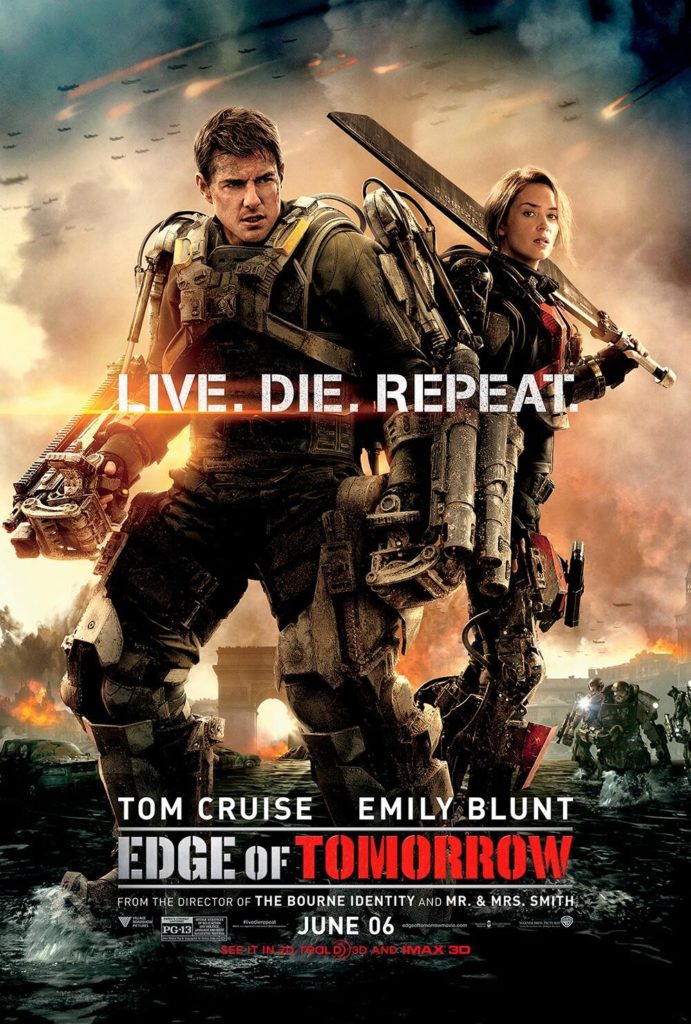‘Edge Of Tomorrow’ … and Eternity
Trick pop quiz: in war, what is most valuable? Overwhelming numbers, superior technology, a more prescient strategy, the element of surprise, or unsurpassed discipline, skill, and morale?
None of the above.
Time is the world’s most precious commodity. It enfolds all other advantages. Given enough time, a determined adversary will increase in numbers, advance in technology, improve in strategy, and locate the chinks in any defense. Given infinite and exclusive time, that adversary becomes unbeatable.
And totally fearless.
Edge of Tomorrow drops the viewer into a near-future world locked in desperate battle with the expansionist inhabitants of an asteroid that punched Germany in the gut. Mainland Europe has been overrun, its people driven out or eradicated by advancing armies of “Mimics,” vicious aliens warriors on perpetual fast-forward. The industrialized nations of Earth, united against this seemingly insatiable threat and fresh off their first victory at Verdun, prepare to commit everything to an assault on the beaches of Normandy, a D-Day parallel made unavoidably obvious by the film’s June 6th release. They place their trust in their mecha armor and in Rita Vrataski (Emily Blunt), the Angel of Verdun, a foot-soldier who slaughtered hundreds of Mimics with minimal training. Little do they know they’ve already run out of time.
Enter Major William Cage (Tom Cruise), a pretty-boy recruiter whose grinning face and inexperienced confidence has cajoled millions to enlist. His commanding officer, for reasons left unstated, press-gangs Cage into the assault’s first wave. To the delight of Tom Cruise-haters everywhere (myself not among them), Cage’s response is pathetic. He hedges, bargains, threatens — anything to avoid facing the enemy. He gets clocked on the head and wakes up on a staging-ground tarmac. He’s been labeled a deserter and assigned to a squad that won’t even show him how to deactivate the safety on his power armor. The next morning, his troop carrier is blown out of the sky by an inexplicably prepared enemy. He lasts all of two minutes on the beach before being riddled with shrapnel.
And then he wakes up on the staging-ground tarmac yesterday morning.
What ensues is a hugely entertaining mashup of Groundhog Day, Saving Private Ryan, and War of the Worlds. Major Cage has become enmeshed in the infinite time-loop used by the Mimics to reset the date every time they make a mistake. Each time he dies — and die he does, in an infinite variety of ways — he reawakens to the smell of asphalt and the tramp of boots, wiser by one more day. He is all that stands between the Mimics and their sudden, overwhelming triumph. Only he can alter the inevitable. The fate of humanity has been deposited upon the shoulders of a coward.
Not having read the Japanese novella upon which the film is based (All You Need Is Kill by Hiroshi Sakurazaka), I can’t tell you whether screenwriter Christopher McQuarrie (Jack Reacher) and director Doug Liman (The Bourne Identity) have crafted a worthy adaptation. What I can tell you, however, is that Edge of Tomorrow is pure cinematic gold. The pacing is surefooted, the plot agile, the action relentless, the emotion real, and the tension surprisingly tangible for what’s basically a war film with a respawn-point (or a choose-your-own-adventure novel in which we keep flipping back to the last story-fork every time the plot goes south). Being forced to relive the same situations ad infinitum results not in tedium but in a firmly-rooted “sense of place” — rare for film — that allows the audience to begin anticipating obstacles and brainstorming solutions alongside the protagonists. And yet the odds are still stacked so severely against Cage that even with time on his side he feels like the lowliest of underdogs in a marathon of futility.
But rise to the challenge he does. Eventually, the knowledge that what awaits him after death is life — even repetitious, no-end-in-sight life — begins to transform him as a person. He sheds his dread and begins to take risks. He lifts his head and looks beyond himself to notice the needs of those around him. And he learns. He learns and trains and experiments and tests until he is the most experienced warrior alive. And by the time he discovers a glimmer of hope, he is at last ready to sacrifice everything he wants for the cause he can no longer ignore.
Time. We have so little of it, so little. It flees away like windblown sand on a beach where life is cheap. And yet we’ll close our eyes in death only to open them upon a day so new its like has not before been seen. We die to rise with Christ.
Oh to see eternity always before us! Oh to be as brave as Major Cage.







































That’s a great analogy. Evoking that kind of interactive mechanic in linear film is a cinematic accomplishment.
Also — I risk embarrassing myself by my ignorance of actors and pop culture — I think it’s ironic that Tom Cruise plays a character with the last name “Cage.”
I have seen this kind of “interactive mechanic in linear film” before, and it’s usually quite entertaining. There’s Groundhog Day, of course, and more recently Harry Potter and the Prisoner of Azkaban, Vantage Point, and Source Code. I suppose you could even say that It’s a Wonderful Life pulled off something similar. But Edge of Tomorrow is definitely at the head of this pack.
Thanks for the review…makes me want to see it!